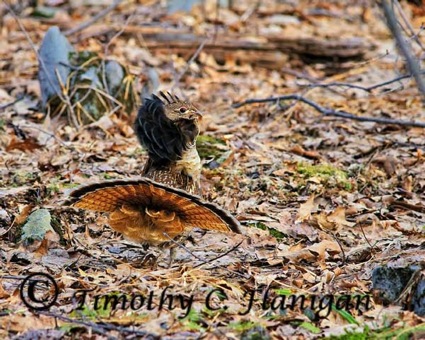Being ready is a vitally important key to capturing great wildlife images and preparedness begins the moment that the camera is pulled from the camera bag. As soon as you take the camera in hand, consider the overall light conditions and set the camera’s ISO (light sensitivity) to a suitable speed for the available light. Darker conditions require higher speeds and vice versa. The wise photographer will always check all and adjust the camera settings immediately prior to any photo session.
Consider the subjects that you intend to photograph and set the camera mode settings to suit. For moving subjects, such as wildlife, you may wish to select “S,” Shutter Priority and a shutter speed that will stop the action of a walking deer or a flying bird. The faster the action, the faster the shutter speed must be to freeze that action.
If you are contemplating a scenic photo you may wish to select “A,” Aperture Priority and a small F-stop setting that will provide the greatest depth-of-field, so that the entire vista is in sharp focus, (that is a larger number such as F16 or F22.) If your photographic mission is one of Macro or close-up photography, such as a wildflower portrait, you may wish render the background out of sharp focus. A more open F-stop will accomplish that goal. (That is a smaller number such as F2.8 or F3.5.)
If your goal is total control for the greatest creativity potential, select the “M,” Manual settings, and a generally suitable pairing of F-stop and shutter-speed, so that you are ready to shoot as quickly as possible.
The opportunity to capture this ruffed grouse image was very fleeting. Success required a quick and purposeful readjustment of the camera’s settings when ambient light conditions changed suddenly from bright sun to deep shade. I was slowly cruising a remote forest roadway in a vehicle looking for strutting male grouse when storm clouds suddenly blocked the sun and cut the available light by one half. I paused; I reset the camera’s ISO to 400 and selected a slower shutter speed to take advantage of the dim light. One mile farther down the road, the camera was ready and the image was captured. ~Tim Flanigan
 Tim Flanigan was born and raised in Somerset County, Pennsylvania, where he was mentored as an outdoorsman by his paternal grandfather who ignited his lifelong thirst for knowledge of the natural world. Experimenting with photography at an early age, he soon realized that the camera enhanced his ability to study and record all things wild and natural. Throughout his career, he has been resolute to rapidly changing photographic technology and the skills requisite for success, from box cameras and black and white film to the digital cameras and electronic darkrooms of today.
Tim Flanigan was born and raised in Somerset County, Pennsylvania, where he was mentored as an outdoorsman by his paternal grandfather who ignited his lifelong thirst for knowledge of the natural world. Experimenting with photography at an early age, he soon realized that the camera enhanced his ability to study and record all things wild and natural. Throughout his career, he has been resolute to rapidly changing photographic technology and the skills requisite for success, from box cameras and black and white film to the digital cameras and electronic darkrooms of today.
According to Tim, “The great charm of photography is its ability to capture a unique moment in time and share it with others.” During a 30-year career in the outdoors, he used his camera to create and present educational and entertaining programs that he continues to update and present to diverse audiences. His presentations have appeared at outdoor shows, sportsmen clubs, garden clubs, state agencies, and various organizations and banquets. Subjects include much of the flora and fauna of North America. He also presents outdoor photography seminars and leads photographic and naturalists’ tours.
Tim has been producing top-quality photographic images for the print media for more than 30 years with photo credits in numerous venues including books, magazines, newspapers, greeting and postcards, calendars, travel brochures, phone books, advertisements, restaurant decor, on-line, etc. His photography and writing have garnered numerous national, regional and state awards.
Tim is the Southcentral Field Editor for the Pennsylvania Outdoor Times, a contributing photographer to The Upland Almanac, The Ruffed Grouse Society, Buckmasters and Buckmasters On-Line. He is published in Wildfowl Carving magazine, North American Whitetail magazine, Westsylvania magazine and Game and Fish Publications. His photography can also be seen on the covers of Pennsylvania Game News magazine and its annual calendar.
He enjoys membership in the Outdoor Writers Association of America (OWAA), the Southeastern Outdoor Press Association (SEOPA), the North American Nature Photography Association, the Professional Outdoor Media Association (POMA) and the National Association of Photoshop Professionals. He is also a Past-President and member of both the Pennsylvania Outdoor Writers Association and the Mason/Dixon Outdoor Writers Association. Membership he also enjoys includes the Bedford County Arts Council, Allegany Area Art Alliance and the Allegany Arts Council.
Tim, and his wife Debbie operate Nature Exposure, an outdoor writing and photography marketing business in Bedford, Pennsylvania, that specializes in supplying content and photography to outdoor publications. Nature Exposure also showcases limited editions of Tim’s award-winning fine art photography, as both framed giclée prints on canvas, as well as premium papers along with his notecard collection. His work is exhibited and sold at various art galleries, art shows and festivals. For more information, please visit their new website: www.natureexposure.com. E-mail Tim at tim-natureexposure@comcast.net, or call 814-623-7865.
Tim Flanigan has been producing top-quality photographic images for the print media for more than 30 years.Tim, and his wife, Debbie, operate Nature Exposure, an outdoor writing and photography marketing business in Bedford, Penn. View all posts by Tim Flanigan